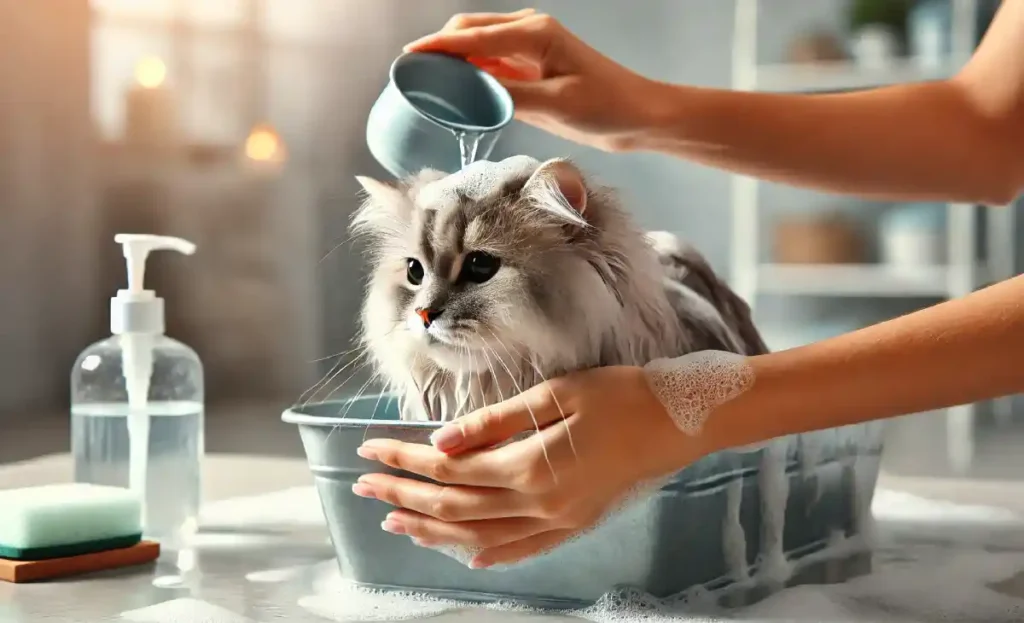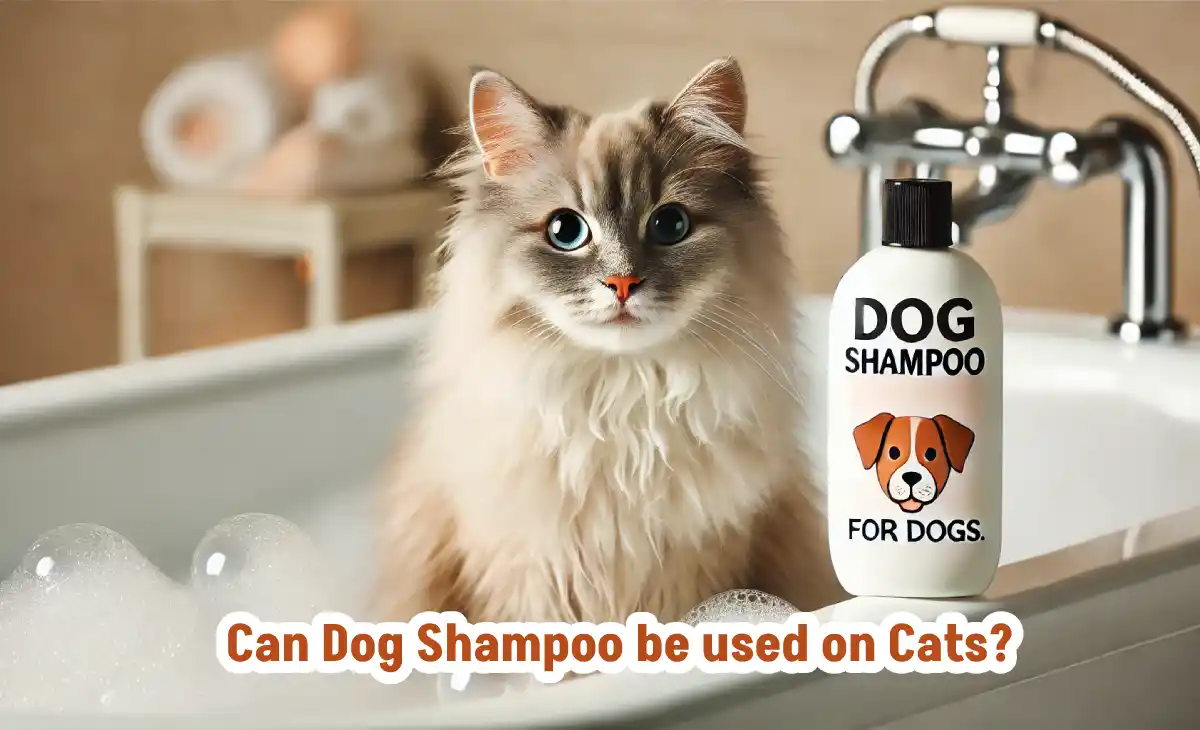As a pet owner, you may wonder if dog shampoo could work for cats too. While both are furry friends, cats and dogs have very different needs, especially when it comes to grooming. Bathing products designed for dogs may not suit a cat’s sensitive skin. So, is it ever safe to use dog shampoo on your cat?
This guide will explore whether dog shampoo is safe for cats, how cat skin differs from dog skin, the risks involved, and safe alternatives for cleaning your cat. Understanding these differences helps you make informed decisions for your pet’s health.
Why Cat and Dog Shampoos Are Different?
Dog and cat skin might seem similar, but they have distinct needs and structures. Cats have thinner, more sensitive skin than dogs, making them more prone to irritation from strong chemicals.
The pH balance between cat and dog skin also differs significantly. Dog skin tends to be more alkaline, while cat skin leans towards a more acidic pH, making pH-balanced cat shampoos safer and more comfortable.
The Harmful Ingredients in Dog Shampoo for Cats
Dog shampoos often contain ingredients that target specific dog-related skin issues like odor or flea infestations. Here are some ingredients commonly found in dog shampoos that may harm cats:
1. Insecticides and Flea Treatments:
Dog shampoos may contain insecticides or chemicals that kill fleas, ticks, and other pests. While safe for dogs, many of these chemicals are dangerous for cats. Cats are highly sensitive to pyrethrins and pyrethroids, common flea-killing agents in dog products.
2. Essential Oils:
Many dog shampoos include essential oils like tea tree oil or eucalyptus, which can be toxic to cats. A cat’s liver does not process these oils effectively, leading to potential toxicity or skin irritation.
3. Artificial Fragrances:
Strong fragrances in dog shampoo can irritate a cat’s respiratory system and sensitive skin. Cats groom themselves often, and they might ingest these chemicals, increasing the risk of gastrointestinal distress.
Using the wrong shampoo even once can cause itching, dryness, or allergic reactions in cats. To avoid these risks, it’s always better to choose products specifically made for cats.
Can Dog Shampoo Be Safely Used on Cats?
Though dog shampoo might seem harmless, using it on a cat comes with risks. The most common issue with dog shampoos on cats is chemical sensitivity. Cats are more sensitive to certain ingredients, and these reactions can range from mild irritation to severe allergic responses. Veterinary experts agree that pet owners should avoid using dog shampoo on cats, especially if the shampoo contains insecticides or essential oils.
Potential Risks to Your Cat’s Health:
Some of the risks associated with using dog shampoo on cats include:
- Skin Irritation and Allergic Reactions: Dog shampoos can lead to itching, redness, and skin inflammation in cats. These reactions may not appear immediately but can cause discomfort over time.
- Toxic Reactions: If the dog shampoo contains tea tree oil or other essential oils, it can lead to toxic reactions in cats. Ingesting these oils during grooming may cause vomiting, lethargy, or even organ damage in severe cases.
Case Example: Cat Reactions to Dog Shampoo:
A study in the Journal of Feline Medicine and Surgery noted cases where cats showed allergic symptoms after exposure to dog grooming products. Pet owners reported symptoms like excessive grooming, hair loss, and skin redness in cats exposed to dog shampoos. These cases highlight the importance of using only cat-specific products for grooming.
Safer Alternatives to Dog Shampoo for Cats
If you don’t have cat shampoo on hand, there are safe and effective alternatives to consider. These options can help you keep your cat clean without exposing them to potential irritants or toxins.
Plain Water Baths for Minor Cleaning:
If your cat only needs light cleaning, a plain water rinse can work wonders. Cats naturally groom themselves and often don’t require frequent baths. A simple water rinse can remove minor dirt and debris, giving them a fresh, clean look without using any harsh chemicals.
Cat Wipes for Convenient Cleaning:
Cat-specific grooming wipes offer an effective and convenient alternative to shampoo. These wipes are formulated to be gentle on cat skin and fur, removing dirt without needing a full bath. Look for wipes labeled “unscented” and “hypoallergenic” for best results, as some wipes with strong scents might still irritate your cat’s sensitive skin.
How to Safely Bathe Your Cat?

Bathing a cat can be challenging, as most cats aren’t fans of water. However, with the right approach and products, you can give your cat a safe and stress-free bath.
Gather the Right Supplies:
Having everything ready before you start will make the process smoother. Here’s a checklist for a successful cat bath:
- Cat-specific shampoo: Look for pH-balanced, hypoallergenic products.
- Towels: Keep several towels on hand for drying.
- Cup or gentle sprayer: Avoid spraying water directly on your cat’s face to keep them calm.
Steps for a Cat-Friendly Bath:
- Wet your cat gradually: Use lukewarm water, as cold or hot water can stress your cat. Start from the back and avoid the face.
- Apply cat shampoo carefully: Gently work the shampoo into their fur, avoiding the eyes and ears.
- Rinse thoroughly: Residual shampoo can lead to itching or skin irritation, so ensure you rinse completely.
- Dry gently: Use a soft towel to dry your cat without rubbing too hard. Let them air dry in a warm room if possible.
Following these steps helps make bathing less stressful for your cat while keeping their skin and fur healthy.
What To Do If Your Cat Reacts to Dog Shampoo?
If you’ve used dog shampoo on your cat and notice unusual behavior or skin issues, it’s essential to act quickly. Here are some steps to follow if your cat shows signs of a reaction.
Immediate Actions for Mild Symptoms:
If your cat seems itchy or uncomfortable, rinse them with clean, lukewarm water. This helps remove any leftover shampoo from their skin. Keep an eye on your cat for a few hours to see if the symptoms improve.
When to Call Your Veterinarian:
If your cat’s reaction includes vomiting, difficulty breathing, or lethargy, contact your veterinarian immediately. These could be signs of a toxic reaction. In such cases, prompt veterinary assistance can prevent further complications and ensure your cat’s safety.
Regular Cat Grooming Practices for a Healthy Coat
Keeping your cat clean doesn’t always require a full bath. Regular grooming with cat-safe tools can minimize the need for baths and promote a healthy coat. Here are some essential grooming practices for your cat’s hygiene.
Brushing to Prevent Matted Fur and Reduce Shedding:
Brushing your cat regularly helps reduce loose fur, which can otherwise lead to matting or excessive shedding. It also distributes natural oils, keeping your cat’s coat smooth and healthy. Short-haired cats benefit from weekly brushing, while long-haired breeds might require daily grooming.
Using Dry Shampoo as a Low-Stress Option:
Dry shampoo designed for cats can be a quick and safe alternative to bathing. These products absorb oils and odors, freshening up your cat without the need for water. Make sure to read labels to verify that the product is safe for cats.
FAQs
Can I Use Dog Shampoo Just Once on My Cat?
It’s best to avoid using dog shampoo on your cat, even for a single bath. The risks of skin irritation or allergic reactions are too high. Instead, use plain water or a pet wipe if you need a quick solution.
What Happens if My Cat Ingests Dog Shampoo?
If your cat ingests dog shampoo while grooming, watch for symptoms like vomiting, lethargy, or appetite loss. These signs may indicate a toxic reaction. In such cases, contact your veterinarian for immediate advice.
Are There Any Human Products Safe for Cats?
Generally, human products like soaps and shampoos should be avoided for cats. The pH levels in human products are not suitable for cats, leading to potential skin issues. Stick to cat-specific grooming items to keep your pet healthy and comfortable.
Conclusion
While it may be tempting to use dog shampoo for your cat, the risks to their health make it a poor choice. Cats require grooming products tailored to their unique skin needs. Opt for gentle, cat-safe alternatives and consult your vet if you’re unsure about any product.
By using the right products and techniques, you can keep your cat’s coat clean and healthy without compromising their well-being.
For more insights into pet care and safe grooming, check reliable sources like ASPCA’s guide to pet care and always reach out to your veterinarian for personalized advice.




